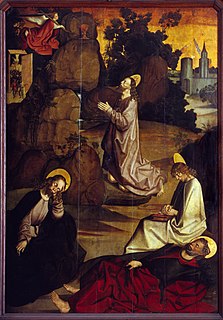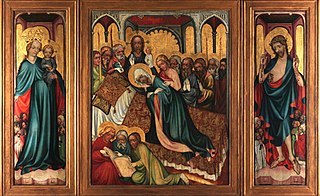 W
WThe Adoration of Our Lord from Hluboká is a panel painting dating from the period around 1380, ascribed to the Master of the Třeboň Altarpiece or his workshop. It is on display in the permanent collection of the Aleš South Bohemian Gallery in Hluboká nad Vltavou as a loan from National Heritage Institute in České Budějovice.
 W
WThe Ark of Doudleby (1494) is a set of three double-sided painted panels that were part of a winged altar, the centre of which was probably a cabinet with a statue of Pieta. This incompletely preserved altar is the finest set of late Gothic paintings in the collection of the Aleš South Bohemian Gallery in Hluboká nad Vltavou.
 W
WCrucifixion from Nové Sady, is part of a larger altar polyptych called the Rajhrad Altarpiece. Its author is the last important personality of Czech panel painting of the pre-Hussite period, known as the Master of the Rajhrad Altarpiece. The painting is on display in the permanent exhibition of the National Gallery in Prague.
 W
WThe Death of the Virgin Mary of Košátky is a Bohemian panel painting from the period around 1340-1350.
 W
WThe Wrocław Holy Trinity is a Bohemian panel painting dating from the period around 1350.
 W
WThe Kaufmann Crucifixion is a Bohemian Gothic panel painting by an unknown artist that dates from 1340-1360. It was most probably the central part of a relatively small folding altarpiece.
 W
WThe Litoměřice Altarpiece (1505–1507) was a large altar retable, in all likelihood with two pairs of movable wings and two pairs of fixed ones. From these wings, six panels have survived, two of which are painted on both sides. The movable wings on the left-hand side of the altar are presumed lost. The altar wing depicting Christ on the Mount of Olives belongs to the Diocese of Litoměřice, while the other panels are owned by the Regional Museum in Litoměřice. It is the largest surviving set of panel paintings by an anonymous late Gothic and early Renaissance painter called the Master of the Litoměřice Altarpiece. The altarpiece is part of the permanent collection of the North Bohemian Gallery of Fine Art in Litoměřice.
 W
WThe panel painting of The Madonna between St Catherine and St Margaret dating from the period before 1360 most probably formed the central part of a lost altarpiece in the Cistercian Abbey of Zlatá Koruna. It is a key work of early Bohemian Gothic painting. It is on display at the permanent collection of the Aleš South Bohemian Gallery in Hluboká nad Vltavou.
 W
WThe Enthroned Madonna of Kłodzko is a Bohemian panel painting dating from 1343 to 1344 that was originally the central part of a larger winged altarpiece. The altarpiece's donor was Archbishop Arnošt of Pardubice, who is portrayed in the bottom left-hand corner.
 W
WThe Veveri Madonna, also called the Madonna of Veveri, is an tempera painting by the unknown moravian, bohemian artist generally called Master of Vyšší Brod. The altarpiece was commissioned after 1344 by Margrave John Henry of Luxembourg for the romanesque church of Assumption of Our Lady, In the neighborhood of royal Veveří castle in Brno, Moravia, Czech Republic. Exhibited in Diocesan Museum in Brno. The panel was one of the first Madonnas painted by the artist. Albert Kutal a Czech scholar called it "a truly rare and extraordinary work".
 W
WThe Zbraslav Madonna comes from the parish church of St James the Greater in Zbraslav. It is on long-term loan at the permanent exhibition of the National Gallery in Prague.
 W
WPuchner's Ark is a Gothic retable comissioned in 1482 by Nikolaus Puchner, Grand Master of the Knights of the Cross with the Red Star, for the church of St. Francis of Assisi in Prague's Old Town. The anonymous author of the panel paintings is referred to as the Master of the Puchner Altar. Part of the altar is on display in the National Gallery in Prague.
 W
WThe Roudnice Altarpiece is a three-part winged altar from the provost's church in Roudnice nad Labem, one of the oldest completely preserved Gothic retables from the period around 1410-1420. It is on display in the permanent exhibition of the National Gallery in Prague.
 W
WSaint Catherine of Alexandria stands out among Theodoric's paintings in the Chapel of the Holy Cross, especially for her richly decorated clothing. The painting is exhibited in the collection of medieval art of the National Gallery in Prague.
 W
WSaint Jerome is one of the finest paintings by Master Theodoric in the Chapel of the Holy Cross at Karlštejn. He has an honourable place in the hierarchy of the Holy Fathers and his portrait is placed in the south window niche of the chapel together with St. Augustine, St. Ambrose and St. Gregory. It is one of the oldest and most frequently reproduced depictions of St. Jerome. The painting is exhibited in the collection of medieval art of the National Gallery in Prague.
 W
WSaint Luke the Evangelist is one of the most impressive panel paintings by Master Theodoric, intended for the decoration of the Chapel of the Holy Cross in Karlštejn. It may be a self-portrait of Theodoric himself. It is exhibited in the collection of medieval art of the National Gallery in Prague.
 W
WSaint Matthew the Evangelist formed an almost symmetrical counterpart to the image of Saint Luke on the altar wall in the Chapel of the Holy Cross. It is an exceptionally high quality painting by Master Theodoric. The painting is exhibited in the collection of medieval art of the National Gallery in Prague.
 W
WSaint Maurice by Master Theodoric is probably the first depiction of a black man in Czech painting (1360-1365). The extraordinary importance of this knight in the conception of the Chapel of the Holy Cross is evidenced by the portrait's placement in the main space of the presbytery adjacent to the painting of St. George and the Bohemian patron saint St. Vitus.
 W
WSaint Simon is one of the paintings attributed to Master Theodoric. In the Chapel of the Holy Cross at Karlštejn, his image is placed on the eastern (epistle) wall of the presbytery behind a dividing metal grille.
 W
WThe St Catherine Altarpiece is a set of panel paintings from the period around 1515 that is ascribed to the workshop of the Master of the Litoměřice Altarpiece. A total of six panel paintings survive from the original retable: one wing painted on both sides and two panels painted on one side in the collection of the National Gallery in Prague and two panels in the private collection of G. Schäfer (Schweinfurt).
 W
WSt George's Altar is a large Gothic altarpiece from the 1460s-70s, originally placed in the St George's Convent at Prague Castle. It belongs to the property of the Metropolitan Chapter of St. Vitus and is on loan to the exhibition of medieval art of the National Gallery in Prague.
 W
WSt. Charles the Great (Charlemagne) is included in the set made for the Chapel of the Holy Cross at Karlštejn by Master Theodoric himself. The portrait was placed in a prominent position in the middle of the row of rulers on the west wall of the nave. The quality of the artwork ranks it among the finest works of 14th century European painting. The painting is on display in the collection of medieval art of the National Gallery in Prague.
 W
WThe St. Vitus Madonna comes from the treasure of St. Vitus Cathedral in Prague and is exhibited in its original frame in the permanent collection of the National Gallery in Prague.
 W
WThe Třeboň Altarpiece, also known as Wittingau altarpiece, is one of the most important works of European Gothic panel painting. Of the original large altarpiece retable created in about 1380 by an anonymous Gothic painter called the Master of the Třeboň Altarpiece, three wings, painted on both sides, have survived. The altarpiece is one of the works that helped towards the emergence of the International Gothic style and which influenced the development of art in a broad European context.
 W
WThe Vyšší Brod (Hohenfurth) cycle, ranks among the most important monuments of European Gothic painting. It is made up of nine panel paintings depicting scenes from the Life of Christ, covering his childhood, Passion and resurrection. These paintings were made between 1345 and 1350 in the workshop of the Master of Vyšší Brod that was most probably based in Prague. The pictures were either meant for a square altar retable or else they decorated the choir partition of the church of the Cistercian Abbey in Vyšší Brod.